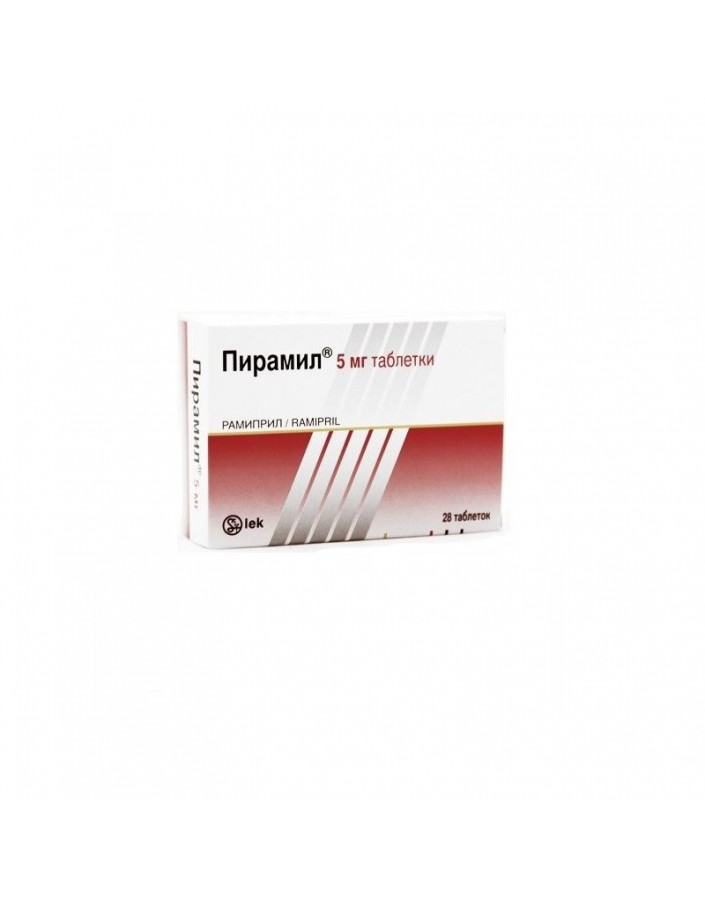




Security policy (edit with Customer reassurance module)

Delivery policy (edit with Customer reassurance module)

Return policy (edit with Customer reassurance module)
Pyramil pills:
1 tab. contains Ramipril 2.5, 5 and 10 mg;
Excipients: microcrystalline cellulose, pregelatinized starch, precipitated silica, Glycine hydrochloride, glyceryl dibehenate, iron dye, yellow oxide;
in packing of 28 pieces.
Pyramil has a hypotensive, vasodilating, cardioprotective, natriuretic effect.
Arterial hypertension; chronic heart failure, incl. after acute myocardial infarction in patients with stable hemodynamics; diabetic nephropathy and chronic diffuse kidney disease (non-diabetic nephropathy); reducing the risk of myocardial infarction, stroke or coronary death in patients with coronary artery disease, with an increased risk of cardiovascular diseases, including patients who have had a myocardial infarction, transcutaneous transluminal coronary angioplasty, aorto-coronary bypass surgery (in a clinically stable state).
Hypersensitivity to ramipril or other ACE inhibitors; angioedema in history, including and associated with prior therapy with ACE inhibitors; pregnancy, breastfeeding, age after 18 years (safety and efficacy not determined).
From the side of the cardiovascular system and blood (blood formation, hemostasis): hypotension (10.7%), incl. postural (2.2%), stenocardia (2.9%), syncope (2.1%), heart failure (2%), myocardial infarction (1.7%), vertigo (1.5%), pain in chest (1.1%), less than 1% - arrhythmia, palpitations, hemolytic anemia, myelodepression, pancytopenia, thrombocytopenia, eosinophilia, agranulocytosis; vasculitis
On the part of the gastrointestinal tract: nausea (2.2%), vomiting (1.6%), diarrhea (1.1%), less than 1% - dry mouth or increased salivation, anorexia, dyspepsia, dysphagia, constipation, abdominal pain, gastroenteritis, pancreatitis, hepatitis, abnormal liver function (cholestatic jaundice, fatal necrosis of the liver with a fatal outcome), change in the level of transaminases.
From the nervous system and sensory organs: dizziness (4.1%), headache (1.2%), asthenia (0.3%), less than 1% - cerebrovascular disorders, amnesia, drowsiness, convulsions, depression, sleep disorder, neuralgia, neuropathy, paresthesia, tremor, hearing loss, blurred vision.
On the part of the respiratory system: unproductive cough (7.6%), upper respiratory tract infection, less than 1% - dyspnea, pharyngitis, sinusitis, rhinitis, tracheobronchitis, laryngitis, bronchospasm.
Urogenital: impaired renal function (1.2%), less than 1% - proteinuria, oliguria, edema; impotence.
Dermatologic: urticaria, prurigo, rash, erythema multiforme, photosensitization.
Other: less than 1% - weight loss, anaphylactoid reactions, increased urea nitrogen and creatinine, angioedema (0.3%), arthralgia / arthritis, myalgia, fever, increased antinuclear antibody titer, hyperkalemia, changes in enzyme activity, concentration bilirubin, uric acid, glucose.
Piramil is taken orally, for hypertension - the initial dose is 2.5 mg 1 time per day, with long-term therapy - 2.5–20 mg / day in 1–2 doses. In heart failure in the post-infarction period in the initial dose of 2.5 mg 2 times a day; in case of failure, 5 mg 2 times a day, with marked hypotension or diuretics, 1.25 mg 2 times a day. In case of renal failure (glomerular filtration less than 40 ml / min and creatinine level more than 0.22 mmol / l), the initial dose is 1/4 of the usual one with a gradual increase to 5 mg / day (not more).
Store in a cool and dark place, protected from light and moisture, at a temperature not higher than 25 ° C.